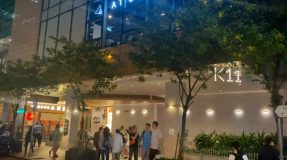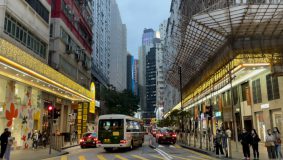Hybridity City: Mall
Directed by: Minsoo Kim (3036050491)
Subject Matter
As the title, “hybridity city,”reflects, the key theme of the video is deeply related to describing Hong Kong as a city of cultural hybridity. The video delves into how the mall, especially K11 Musea in this video, shows the theme of hybridity as a venue of cultural concentration. This is shown through the existence of different shopping stores of international brands coming from all over the world, which serves as a representation of cultural concentration.
To further elaborate the subject matter in the video, in order to help the audience understand the root of Hong Kong’s cultural hybridity, the video describes a brief history of Hong Kong, thus explaining how Hong Kong came to show both orientality of Asia and occidental aspects of Western countries at the same time. This is due to its unique history and proximity to China and other Asian countries. Although Hong Kong, as a former British Colony, had been greatly influenced by Western cultures, the proximity and trade connections with China and other neighboring countries adorned it with oriental aspects, thus eventually leading to a formation of unique hybridity of culture. Hong Kong’s cultural richness was founded on this historical ground.
Production Method
The research conducted was mainly done through secondary research, which consisted of data collected for other purposes or different researches. The main source I looked for were some historical documents to understand the historical backgrounds on the diverse cultural characteristics of Hong Kong. In addition to that, multiple academic journals also helped me through the process of delivering the message of hybrid culture and enriching the content of the video.
During the footage-taking process, the priority was to find an appropriate visual representation of the theme. First and foremost difficulties in this stage was the sheer amount of the work it required, as it took substantial time to find a suitable spot for the footage that would satisfy both aesthetic prospects and thematic facets of the final results.
Also, I used a transition method to collage two similar-looking footages of night views and morning views, which resonates with the narration, “the coexistence of both past and present.” I believe this enhanced the delivery of the content and is a conducive tool to augment what the video is trying to convey to its audience.
Reflection
Figure 1. Video still of K11 mall
 (video still)
(video still)
In order to show throughout the video how culturally rich Hong Kong is, and how both orientalism and occidentalism is reflected through its architecture, appropriate scenery that visually represents this key theme was required. The video includes K11 musea and other ordinary city streets of Hong Kong. The reason why these sceneries were selected is, first, K11 serves as a venue that represents cultural concentration, through its spatial quality of providing global merchandise, especially for apparel products, from international brands of diverse countries all over the world.
Figure 2. Video still of city streets
 (video still)
(video still)
Secondly, as it is shown through the figure above, the ordinary streets of Hong Kong display its aspect as a cultural melting pot of diversity, as the scenery shows how the city’s street markets consist of both traditional Chinese medicine shops juxtaposed next to Western coffee shops and other luxury fashion brands.
Reflecting on the experience of producing the final video essay, I personally enjoyed the process a lot, as the experience of researching Hong Kong history and finding the connection of how those historical roots came to be reflected through Hong Kong’s daily architectural views as a result. It was a valuable experience allowing me to find newness in ordinary backdrops of Hong Kong’s streets, which I encounter on an everyday basis wherever I visit. Now I find myself walking the same streets and places that I used to go, but observing different points of views and being interested in new potential architectural interpretations of such buildings.
This course widened my insights in terms of viewing architectural buildings, and allowed me to see those hidden structural meanings behind those buildings. Those architectural importance I have learned with reference to the films is a valuable perspective, which I would not have been able to acquire otherwise. This final video essay is one of the reflections that shows what I earned through the course CCHU 9034 – Architecture and Film
Works Cited
Bellis, D. (n.d.). Royal Geographical Society (hong kong) RGS HK – Exciting Tales from Hong Kong’s history seen through its historic photos. Royal Geographical Society (Hong Kong) RGS HK – Home. https://www.rgshk.org.hk/events-2019/item/2175-exciting-tales-from-hong-kong-s-history-seen-through-its-historic-photos.html
Farrer, J., & Smith, A. (n.d.). The globalization of Asian cuisines. SpringerLink. https://link.springer.com/book/10.1057/9781137514080
Leung, C. K. (2023, May 11). Hong Kong. Encyclopædia Britannica. https://www.britannica.com/place/Hong-Kong
Morales, J. J. (2017, April 6). Early photographs of Hong Kong at Wattis Fine Art. Asian Review of Books. https://asianreviewofbooks.com/content/early-photographs-of-hong-kong-at-wattis-fine-art/
National Geographic. (2021, May 3). Discover why Hong Kong is Asia’s melting pot. Travel. https://www.nationalgeographic.com/travel/article/hong-kong-1 ]
Minsoo Kim
3036050491
Although your video does not specifically focus on a particular space, but you expanded your research from the site to the ideas of globalization and cultural diversity well. The narrative is well-structured. It will be even better if you can analyze a bit more on how internationalized the mall is – where are the brands from? Or you can also comment on the architectural design (not only the space but maybe also the ambience, signage and etc.) of the mall and how it reveals a culturally-diverse and globalized HK? Digging deep into these details could support your arguments and making them more convincing.